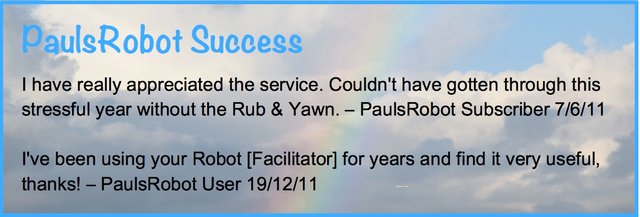Rogerian Use in PaulsRobot
The three Rub & Yawn techniques used at PaulsRobot.com are Reach & Withdraw, 6-Direction and Rogerian. The user can switch among these at choice, whichever seems to work best at the time.
Carl Rogers' theory

Carl Rogers, the founder of Person-Centred Therapy, assumed that the most basic drive in a human being is that to self-actualization. It is this drive, nurtured by the skilled counsellor's attitude, that allows the client to sort things out for herself.
The counsellor embodies the "core conditions" in a session, namely
- genuiness (being honest, transparent, hiding nothing)
- acceptance (having and demonstrating unconditional positive regard, with no hint of criticism or judgment toward the client)
- empathy (seeing and feeling things as if from inside the client, with the client's own internal frame of reference).
The counsellor gets the client talking, and the client gives some details of her topic, whatever is on her mind. The topic might be issues at work, or a relationship problem, personal debts, whatever. Just everyday things that people have trouble with. Every now and then, but without interrupting, the counsellor tentatively paraphrases and summarises the details of this just-spoken chunk of topic back to the client, both as to factual and emotional content, to the extent that the emotional content can be perceived. In this way, the client gets to look at her topic again, from a slightly different viewpoint, and can sort it out to some extent in her own mind. Bit by bit it should become clearer. The counsellor's reflection back to the client is tentative, so that if he gets it a bit wrong, the client can correct this.
In very basic terms, that is how Rogerian therapy works. Not only does the counsellor offer no advice, but the counsellor also offers no interpretation.
How PaulsRobot follows Rogers' theory
This explanation details how the Rogerian part works. Other modules contain different procedures, but similar principles obtain.
How could the practitioner-client session procedure described above possibly be replicated by a set of simple web pages, which cannot understand or act upon any of the words the client is saying or anything that the client is feeling?
It works like this. The client sits down in front of a computer with things arranged so that she won't be distracted for maybe 30 minutes, opens up PaulsRobot, and gets ready to start the session. She has some way of taking notes. The PaulsRobot "counsellor" consists of a set of linked web pages that are static, i.e., each page does not change its content at all. There is an audio file attached to the page that plays as soon as the page is opened. The audio is a simple direction to the client, like
OK. Write down some details of your topic as it seems to you now.The words in the audio also appear across the top of the web page, just in case there is something wrong with the audio or the client loses track of what she is supposed to be doing.
She follows the direction, in this case by putting into writing some details of her topic, a few sentences. There are some response options on the screen, and also further how-to details as needed. She selects an appropriate one, in this case probably
I have written down a paragraph about my topic.
This causes the linked web page to open up. The audio immediately says something like
Thank you. Summarise the factual content of that paragraph.So she looks both at the words she just typed and, in her mind's eye, that part of her topic. And she paraphrases and summarises the important points in it. She clicks the appropriate option. The linked web page says something like
Good. Write down how you feel about that paragraph.So the client looks over her reaction to that event and notes it down. Click.
All right. Write down another paragraph of your topic . . . Summarise it . . . Feelings? . . . Another paragraph . . . Summarise it . . . Feelings?These steps are abbreviated here, but each is as complete as in the earlier examples.
Next is a screen asking the client how it's going, as the Robot can't tell, of course, not being human. If it's going fine like this, the client just continues as before, giving details, summarising, noting any feelings etc. If the client want to edit an existing paragraph, she can do so. She can edit any further paragraphs like this before continuing with writing new paragraphs. If she wants to, she can redo the whole thing from scratch. All of these options are carefully covered in the session pages PaulsRobot shows her as the session is going along.
How it feels
Contrary to expectation, most people find that this automated procedure, including the human voice giving session commands, feels like a real session with a live counsellor. One may know that it is automated, but that does not change how it feels.
Why it works
Now, what is happening is that in doing all this, she is examining and personally reflecting on her topic in minute detail. The rewrite is not so much about correcting any typos that she made, but more the point that her topic is changing before her eyes as she clarifies parts of it and sorts it out in her mind. And this is exactly what takes place in a normal Rogerian therapy session.
Rogers' core conditions
Genuineness
Genuineness is the quality of the counsellor being real, transparent, and not trying to hide any of his personal thoughts or feelings from the client. The client has no expectation of any personal reaction at all to her from PaulsRobot, good or bad, whatever she says or however she acts.
Unconditional acceptance
Similarly, the client cannot possibly pick up any criticism or hint of disapproval or lack of acceptance, as PaulsRobot is not a human being and the responses will always be neutral in tone.
Empathy
Lastly, of course PaulsRobot cannot feel with the client and see life from her internal frame of reference. However, the main reason for this empathy in a conventional session is so that the counsellor can reflect back the client's topic, in summarised form, both as to factual content and emotional content. And in this way the client is given perhaps a different view on her topic, and from this is able to see it more clearly. The Rogerian option of PaulsRobot regular session procedure will cause this reflection of both factual and emotional content to occur over and over in the normal course of the session.
Conclusion
Hopefully, this will give you a good idea of how PaulsRobot works with a client in a straightforward Rogerian session. And although only an example, it might encourage the idea that PaulsRobot counselling could possibly be a viable alternative to the real thing.
Sources: Edited from my article at paulsrobot3.com/1st/theory.htm. Image is fair use of a low-res common photo of a famous individual used for informational/educational purposes.
Questions?
Feel free to ask questions in the comments, and I'll do my best to answer them for you.
Free sessions
To get free online fully-personalized stress-release sessions 24/7, see the links below.
Disclaimer
I am not a licensed practitioner in your area, and no longer give personal sessions. My works, designed for normal people and not clinical cases or the dysfunctional, treat you as a spiritual being and not mere flesh and blood. Use my free websites and videos at your own risk.
Index of my main Steemit blog posts
Table gives post number, title/link, brief notes about content.
Links to some of my stress-release sites
Yawnguy YouTube videos: Entry level. Since 2007, I deliver sessions directly to you by video on your custom topics. Start with Rub & Yawn 1/3.
YawnMachine.com: Entry level. Mobile-friendly. Text-based Rub & Yawn sessions.
PaulsRobot.com: Entry level (more or less). Mobile-friendly. More options to address your own topics. Sessions use three different Rub & Yawn techniques (Reach & Withdraw, 6-Direction, Rogerian). Includes theory and explanations.
RubAndYawn.com: Entry-level. Mobile friendly. Theory/explanations only, no session delivery.
PaulsRobot3.com: Advanced level. Desktop site. Delivers sessions on your custom topics. 3375 session pages in 31 onsite modules, using over 16 different techniques, none of them simply “talking about it”. Includes all relevant theory.
PaulsRobot2.com: Advanced level. Mobile-friendly. Experimental. PaulsRobot functionality but through icons instead of words. Includes automated session record. Video intro.
Yawnguy.com: Entry level. Desktop site. Links to my other sites. Over 100 testimonials. Includes roll-your-own audio session templates.
Facebook: My FB account, not used much.
Twitter: I have @yawnguy, @paulsrobot, @rubandyawn accounts, now coming out of hibernation since 2009.

I've told many people about my topic, and I still have attention on it. Would it help to do this procedure?
Maybe. This Rogerian technique works best with fresh topics. Repeated recounting alone yields diminishing returns. But PaulsRobot.com also uses the Reach & Withdraw and 6-Direction techniques, and all three should be used in conjunction with Rub & Yawn.
If the topic still bothers you after that, you can choose from at least 16 discharge techniques at PaulsRobot3.com that don't involve simply “talking about it”, including positive and negative role-playing, multiple-viewpoints, time-shifting, examining possible spiritual and cosmic influences, and much more.